With vast wilderness and breathtaking landscapes, this region offers some of the best trails in the U.S. Whether you seek family-friendly walks or steep alpine climbs, there’s a path for every adventurer.
From the 20-minute Exit Glacier Trail to the challenging 8.2-mile Harding Icefield route, options vary by difficulty and scenery. Coastal paths like Horseshoe Lake Trail showcase views of Denali, while Chugach State Park provides shorter loops ideal for guided walks.
Seasonal highlights include fall blueberry picking on the X Lake Trail and year-round wildlife sightings near the Eagle River Nature Center. Practical details like elevation gains and trail lengths help hikers prepare for their journey.
Table of Contents
Key Takeaways
- Trails range from easy ¾-mile loops to strenuous 8-mile treks
- Coastal and mountain views feature prominently on many routes
- Family-friendly options include interpretive nature walks
- Seasonal activities like berry picking enhance the experience
- Detailed trail metrics help with trip planning
Why Alaska’s Hiking Trails Are Unmatched
Glaciers, alpine meadows, and dense forests create a hiker’s paradise unlike any other. Over 33% of this region is designated wilderness—the highest in the U.S.—offering trails through untouched ecosystems.
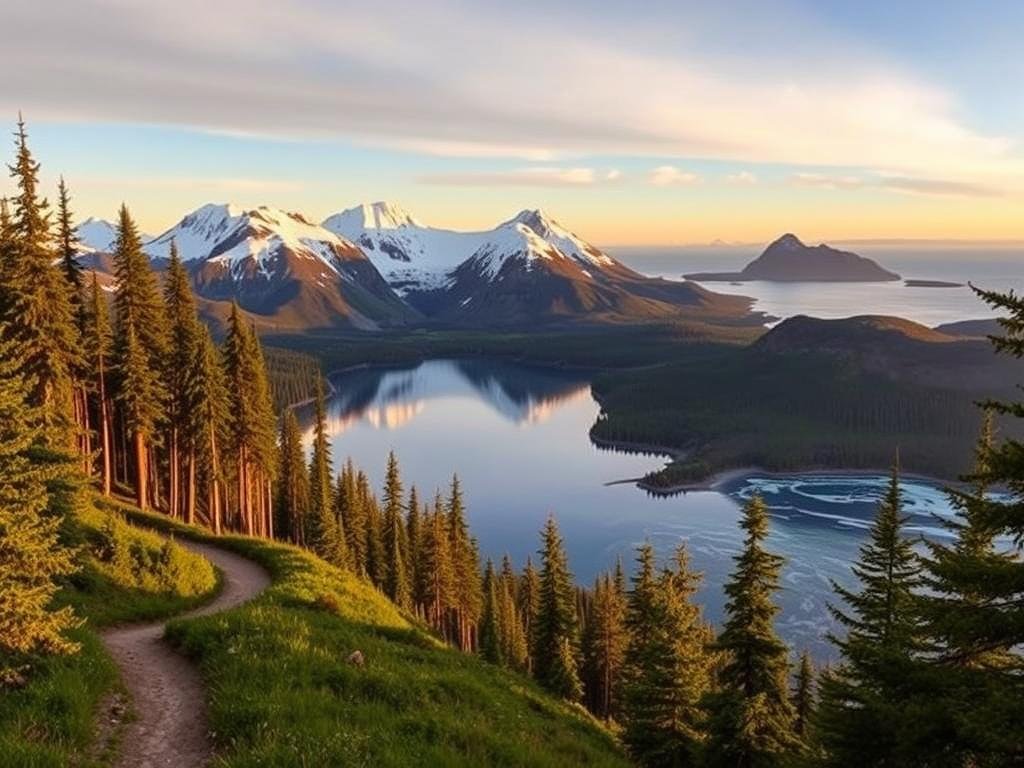
Diverse Landscapes From Glaciers to Alpine Meadows
Coastal rainforests give way to Arctic tundra within miles, showcasing nature’s contrasts. Trails like Exit Glacier and Portage Pass let you walk alongside ancient ice formations. The Chugach forest alone has 5,000+ glaciers, while Denali’s 6 million acres shelter 650 plant species.
Wildlife Encounters and Pristine Wilderness
Spot brown bears, moose, and eagles in Lake Clark or hear caribou tread near Kenai Fjords’ ice fields. Always carry bear spray and follow these safety steps:
- Make noise to avoid surprising animals
- Store food in bear-proof containers
- Stay 100 yards from predators
Educational signs along trails highlight glacial retreat and preservation efforts, ensuring these landscapes remain unspoiled.
Alaska’s Top Day Hikes for Outdoor Adventure
Denali’s alpine vistas and Chugach’s icy valleys deliver unforgettable day hikes. Whether you crave mountain panoramas or easy glacier walks, these trails cater to all skill levels.
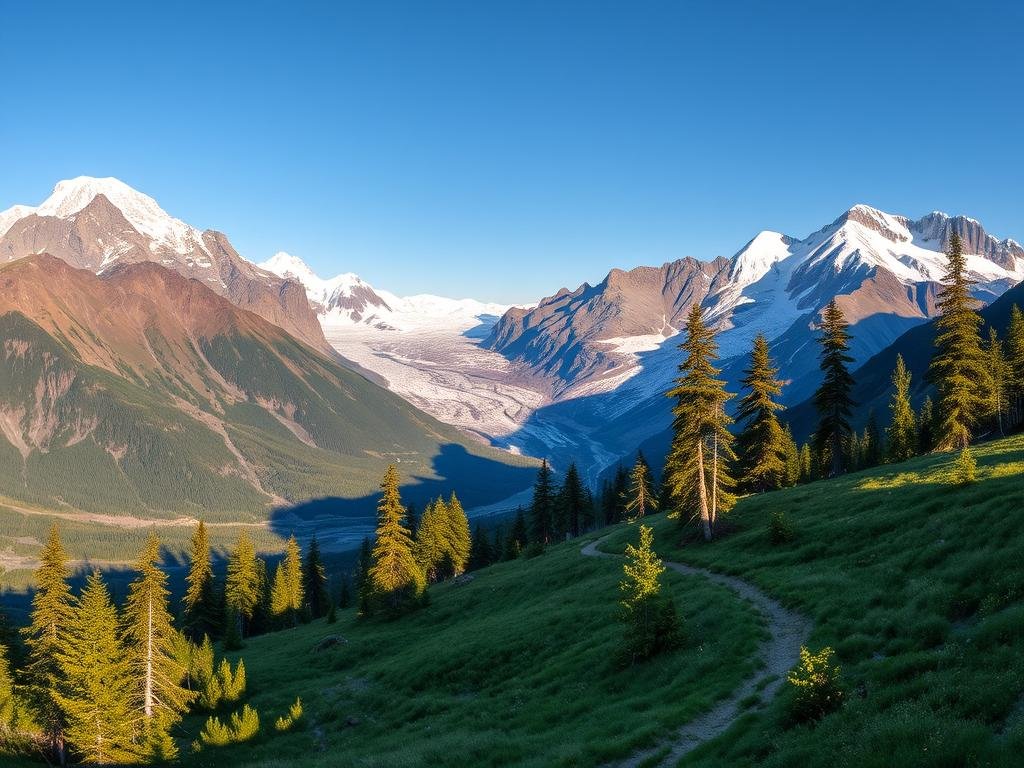
Savage River Loop (Denali National Park)
This 4-mile moderate trek gains 1,500 feet in elevation, offering sweeping views of the Alaska Range. A shuttle drops hikers at the trailhead, with strategic turnarounds for families.
Photographers love the Savage Alpine Trail section for golden-hour light on jagged peaks. Ranger-led programs run summer weekends, explaining local geology and wildlife.
Byron Glacier Trail (Chugach National Forest)
A flat 1-mile glacier trail leads to avalanche-carved ice caves—perfect for young kids or strollers. Summer 2023 saw snow melt by July, but microspikes help navigate lingering patches.
Pack these essentials for both hikes:
- Bear spray (store in side pockets)
- Layered clothing for shifting mountain weather
- Collapsible trekking poles for river crossings
Family-Friendly Hikes with Breathtaking Views
Discover scenic trails perfect for families, offering stunning views and easy access. These routes blend education, adventure, and nature’s beauty—ideal for all ages.

Exit Glacier Overlook Trail
The Exit Glacier Overlook Trail is a 2-mile ADA-accessible path with panoramic ice views. Ranger talks near the visitor center explain glacial recession patterns. Picnic areas along the route feature mountain backdrops.
Bishop’s Beach Walk
At low tide, explore tidepools teeming with sea stars and crabs. The Junior Ranger program here turns beachcombing into a learning adventure. Time your visit for -2.0 tides or lower.
Eagle River Nature Center
This 4-mile loop boasts an 87% moose-sighting success rate. The Rodak Nature Loop has stroller-friendly surfaces, while educational signs highlight local wildlife. Arrive between 10 AM–2 PM for peak animal activity.
Pack these essentials for family hikes:
- Binoculars for spotting eagles and bears
- Layered clothing—mountain weather shifts fast
- Snacks for picnic stops with vistas
Challenging Treks for Experienced Hikers
Steep climbs and technical terrain define these expert-level routes, rewarding perseverance with unmatched vistas. These trails demand preparation, specialized gear, and respect for alpine conditions.
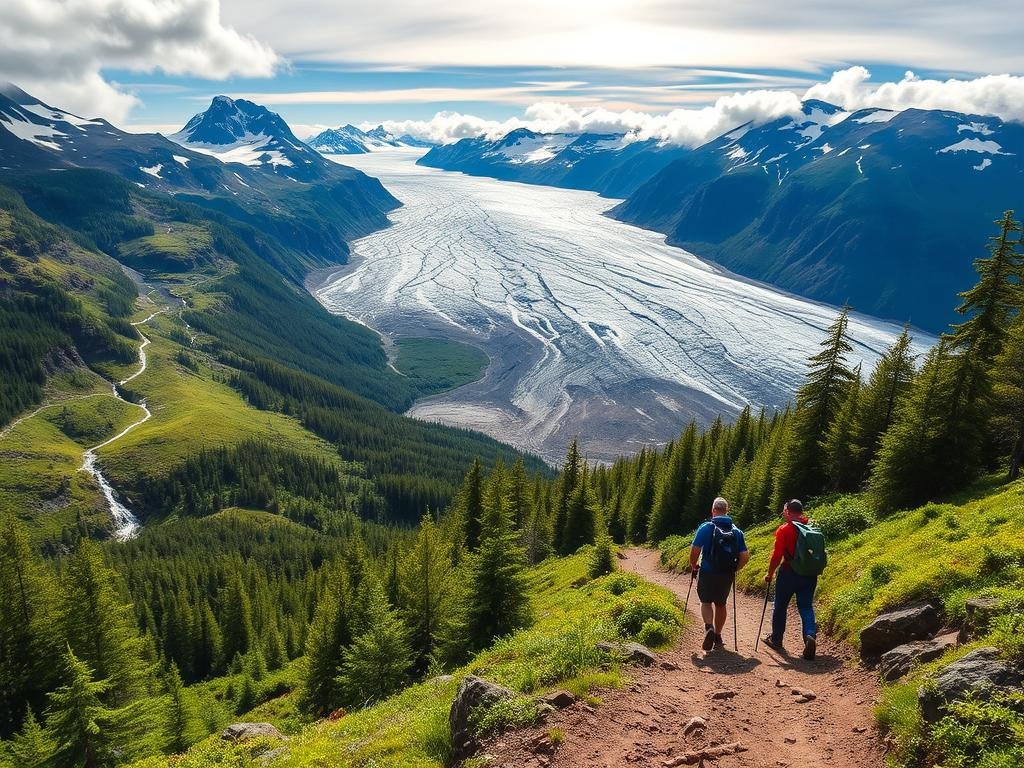
Harding Icefield Trail (Seward)
The Harding Icefield Trail is an 8.2-mile climb with a 3,000′ elevation gain. Summer 2023 required ice axes through June for safe glacier crossings.
Summit views reveal a 700-square-mile ice field—bring layered clothing and trekking poles for shifting weather. Key bailout points exist at mile 2.5 and 4.7 for sudden storms.
Reed Lakes Trail (Hatcher Pass)
This 8-mile out-and-back route features 2,800′ of gain and Class 3 rock scrambles. The Bomber Glacier crossing tests agility, especially early season.
Guides recommend microspikes and helmets for loose scree sections. Unlike the best day hiking spots, this trail demands technical skills.
Essential Gear for Alpine Ascents:
- Ice axe (for Harding’s snowfields)
- Bear spray and noise-makers for wildlife
- Waterproof boots with ankle support
Guided groups provide safety for glacier travel, while solo hikers should file trip plans with rangers. Check trail conditions—snow lingers into July.
Hidden Gems: Lesser-Known Trails
Escape the crowds and discover secluded trails offering untouched beauty and rare geological wonders. These paths deliver solitude and stunning landscapes, with fewer than 500 weekly hikers compared to 5,000+ at popular routes like Flattop.
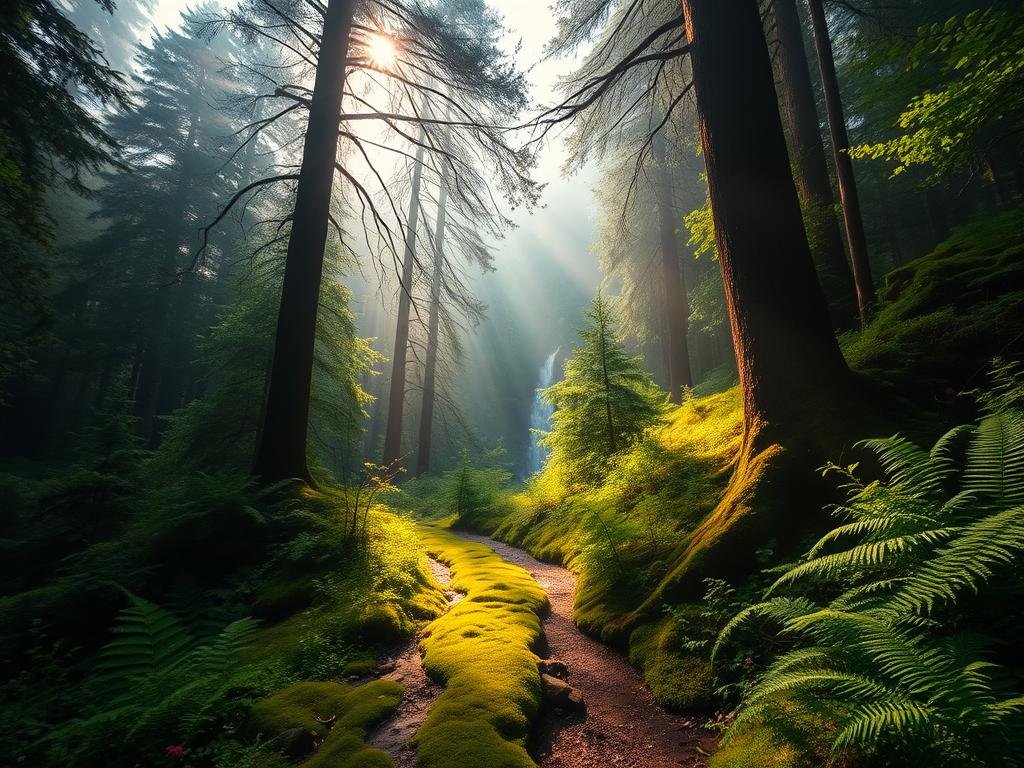
Portage Pass Trail (Whittier)
The Portage Pass Trail is a 4-mile round trip with 1,600 feet of elevation gain. It rewards hikers with panoramic views of a 16-mile glacier and rugged peaks.
Coordinate your hike with the Whittier Tunnel schedule—the only road access. Pack layers; coastal winds shift quickly even in *summer*.
Granite Tors Trail (Fairbanks)
This 15-mile loop features 50-foot granite rock spires and tundra meadows. Midnight sun hikes in June offer 24-hour daylight for extended exploration.
Watch for caribou tracks and follow low-impact camping guidelines to preserve this remote area.
| Trail | Distance (Miles) | Elevation Gain | Best Season |
|---|---|---|---|
| Portage Pass | 4 | 1,600′ | June–Sept |
| Granite Tors | 15 | 2,300′ | May–Aug |
Pro Tips for Hidden Trails:
- Check avalanche forecasts for Portage Pass in early *summer*
- Use wildlife tracking apps to log sightings safely
- Carry a satellite communicator—cell service is unreliable
Coastal Hikes with Ocean Panoramas
Experience breathtaking trails where land meets sea, offering sweeping water views and refreshing ocean breezes. These coastal routes combine scenic beauty with unique wildlife encounters, perfect for those who love the sound of crashing waves.
Tony Knowles Coastal Trail (Anchorage)
This 11-mile paved path winds along Cook Inlet, delivering stunning mountain and water vistas. Accessible from downtown Anchorage, it’s ideal for walking, biking, or rollerblading while spotting beluga whales during summer months.
Several rental shops near the trailhead offer bikes and safety gear. Pack layers—coastal winds can shift suddenly even on sunny days.
Deer Mountain Trail (Ketchikan)
The 6.7-mile climb to 3,000 feet rewards hikers with panoramic views of the Coast Mountains and Tongass Narrows. Check tide tables before starting—some sections become impassable during high water.
Emergency access points near the FAA radio tower provide safety options for sudden weather changes. Cruise ship passengers often complete this hike within 5 hours roundtrip.
Essential Tips for Coastal Adventures:
- Time intertidal zone exploration for low tide (-2.0 or lower)
- Carry waterproof gear—coastal storms develop rapidly
- Use bear spray and make noise in brushy areas
- Check cruise schedules for trail congestion
These oceanfront trails offer some of the most memorable miles in the region, blending rugged coastline with mountain backdrops. Always prepare for changing conditions and respect wildlife habitats along the way.
Historical Trails with Gold Rush Roots
Step back in time on trails where gold seekers once trekked, carrying history in every footstep. The Chilkoot Trail is recognized as the world’s longest outdoor museum, highlighting its historical significance.
Chilkoot Trail: A Journey Through Time
This 33-mile international trail features the infamous 2,500′ Golden Stairs climb. Over 3,000 artifacts from 1897-99 remain visible along the route, including stampeders’ discarded equipment.
The 2023 permit system limits access to 50 hikers daily, preserving the historical park atmosphere. Dyea townsite, a 25-minute drive from Skagway, offers additional gold rush remnants like wharf foundations.
| Aspect | 1898 Stampeders | Modern Hikers |
|---|---|---|
| Packing Weight | 1 ton (required) | 30-50 lbs |
| Trip Duration | 3 months | 3-5 days |
| Navigation | Hand-drawn maps | GPS waypoints |
Key points for your trip:
- Border crossing at Bennett Lake requires passport checks
- Join ranger-led archaeology walks on summer weekends
- Compare stampeders’ gear lists at Trail Center exhibits
The Klondike Gold Rush brought 100,000 people to the region, with about 40,000 reaching the Yukon goldfields. Museum partnerships help preserve this legacy through interactive displays and oral histories.
Essential Gear for Alaska’s Trails
Proper equipment makes the difference between an epic adventure and a risky misadventure. The right gear ensures safety and comfort across changing conditions, from sudden storms to wildlife encounters.
- Layering system: Moisture-wicking base, insulating mid-layer, and waterproof shell for 40°F temperature swings
- Bear-resistant containers: Required in Denali and Kenai Fjords—plastic barrels or Kevlar ursacks work best
- Water treatment: MSR Guardian filters outperform chemical options like Aqua Mira in silty glacial streams
| Category | Summer Essentials | Shoulder Season Add-ons |
|---|---|---|
| Footwear | Trail runners for dry trails | Waterproof boots with ankle support |
| Shelter | Lightweight space blanket | Four-season tent |
| Navigation | Phone with GaiaGPS | Backup compass and paper maps |
Footwear choices depend on terrain. Lightweight boots like Danner Pronghorns handle rocky paths, while approach shoes suit technical scrambles. Always break them in before long hikes.
For emergency water needs, satellite communicators like inReach provide coverage in 87% of remote areas. Test devices beforehand—some valleys have signal dead zones.
Remember these pro tips:
- Practice bear spray deployment upwind—effective range is just 25 feet
- Pack repair kits with duct tape and super glue for quick fixes
- Choose brightly colored gear for visibility during search operations
With plenty of preparation and the right equipment, you’ll stay safe while exploring wild landscapes. Double-check your pack before hitting the trail—it’s your lifeline in unpredictable conditions.
Safety Tips for Hiking in Bear Country
Exploring bear country requires knowledge and preparation to stay safe on the trail. With 3 encounters per 10,000 hikers in 2022, understanding bear behavior reduces risks.
Bears have a 100-foot personal space bubble—entering it may provoke aggression. Black bears often retreat, while grizzlies may stand their ground. Watch for scratched trees, a sign of recent activity.
Key Strategies:
- Make noise with NPS-approved devices (120+ decibels) to avoid surprising wildlife
- Hike in groups of 3–6; larger groups deter curious bears
- Store food in bear-proof containers—smells attract them from miles away
During salmon runs, avoid riverbanks where bears fish. If you spot a carcass, leave the area immediately. Rangers recommend checking trail updates for recent sightings.
If You Encounter a Bear:
- Stay calm and speak firmly—don’t run or scream
- Use bear spray only if the animal approaches within 25 feet
- Back away slowly while facing the bear
Always check in at ranger stations for current conditions. Carry a satellite communicator—cell service is unreliable in remote zones.
Best Times to Hike in Alaska
Timing your hike right unlocks the best experiences across diverse landscapes. Southcentral trails peak from May 20 to September 10, while Arctic routes are safest June 15–August 25.
Summer offers 19+ daylight hours near the June solstice—ideal for long treks. Trails may still have snow through July, so check trail conditions before heading out.
Microseasons matter: Wildflowers bloom mid-June, while fall colors peak in late August. River crossings are safest after spring melt (late May–early June).
- Mosquitoes: Hatch cycles peak in July—DEET repellents work best.
- Winter hikes: December–March for auroras, but pack traction spikes.
- State-wide, coastal trails thaw earlier than interior routes.
Plan around these time frames to enjoy optimal weather and fewer crowds. Always layer clothing—days can shift from sunny to stormy fast.
Conclusion
From the easy Exit Glacier View Loop to the challenging Kesugi Ridge Trail, these routes offer something for every explorer. Whether you seek coastal views or alpine climbs, each path promises unforgettable moments.
Practice Leave No Trace principles to protect these wild spaces. Pack out trash, stay on marked trails, and respect wildlife habitats.
Join the Alaska Hiking Club to earn certifications and connect with fellow adventurers. Share your trip reports and photos to inspire others.
Before heading out, download the NPS app for offline maps and trail updates. Stop by any visitor center for current conditions and ranger tips.

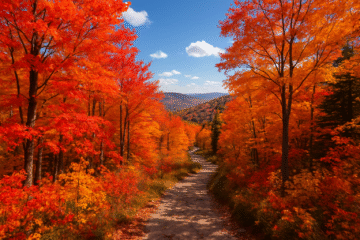
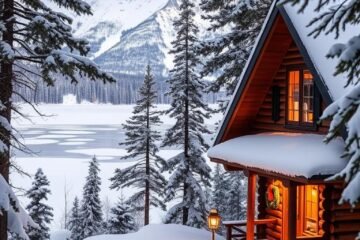
0 Comments